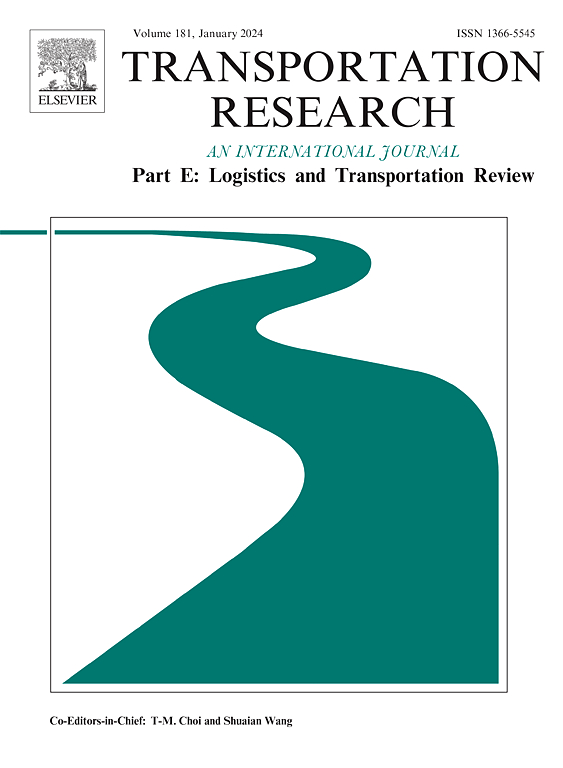Prescriptive analytics for freeway traffic state estimation by multi-source data fusion
IF 8.3
1区 工程技术
Q1 ECONOMICS
Transportation Research Part E-Logistics and Transportation Review
Pub Date : 2025-04-23
DOI:10.1016/j.tre.2025.104105
引用次数: 0
Abstract
In the context of freeway traffic state estimation, this study introduces prescriptive analytics—also known as “predict-then-optimize”—for integrating data from Electronic Toll Collection (ETC) systems and traffic sensors. Traditional single-method data fusion techniques are constrained by inherent limitations. For instance, optimization-based methods are generally predicated on prior assumptions that may induce systematic biases, whereas machine learning approaches are frequently criticized for their lack of interpretability and their inability to elucidate underlying traffic mechanisms. To address these limitations, a novel “retrieval and matching” algorithm is proposed that integrates machine learning with optimization. First, the concept of the “state gene” is introduced to encapsulate traffic structural knowledge representing frequently occurring traffic patterns. In the retrieval phase, a heterogeneous graph conventional network is employed to predict potential state genes for a given scenario. In the matching phase, the predicted state genes are utilized to minimize the discrepancy with the current traffic state. This integration not only enhances the interpretability of the estimation process but also endows the optimization component with reverse inference capability through the incorporation of machine learning. Validation using real-world data from the G92 Freeway in Zhejiang, China, demonstrates high accuracy, yielding Mean Absolute Percentage Errors (MAPE) of 1.12 − 1.65 % during peak periods and 1.28 − 1.67 % during off-peak periods.
基于多源数据融合的高速公路交通状态估计规范分析
在高速公路交通状态估计的背景下,本研究引入了规范分析-也称为“预测-然后优化”-用于整合电子收费(ETC)系统和交通传感器的数据。传统的单方法数据融合技术受到固有局限性的制约。例如,基于优化的方法通常基于可能导致系统偏差的先前假设,而机器学习方法经常因缺乏可解释性和无法阐明潜在的流量机制而受到批评。为了解决这些限制,提出了一种新的“检索和匹配”算法,该算法将机器学习与优化相结合。首先,引入“状态基因”的概念来封装表示频繁发生的交通模式的交通结构知识。在检索阶段,采用异构图传统网络对给定场景的潜在状态基因进行预测。在匹配阶段,利用预测状态基因最小化与当前交通状态的差异。这种集成不仅增强了估计过程的可解释性,而且通过结合机器学习使优化组件具有反向推理能力。使用来自中国浙江G92高速公路的真实数据进行验证,显示出较高的准确性,高峰时段的平均绝对百分比误差(MAPE)为1.12 - 1.65%,非高峰时段为1.28 - 1.67%。
本文章由计算机程序翻译,如有差异,请以英文原文为准。
求助全文
约1分钟内获得全文
求助全文
来源期刊
CiteScore
16.20
自引率
16.00%
发文量
285
审稿时长
62 days
期刊介绍:
Transportation Research Part E: Logistics and Transportation Review is a reputable journal that publishes high-quality articles covering a wide range of topics in the field of logistics and transportation research. The journal welcomes submissions on various subjects, including transport economics, transport infrastructure and investment appraisal, evaluation of public policies related to transportation, empirical and analytical studies of logistics management practices and performance, logistics and operations models, and logistics and supply chain management.
Part E aims to provide informative and well-researched articles that contribute to the understanding and advancement of the field. The content of the journal is complementary to other prestigious journals in transportation research, such as Transportation Research Part A: Policy and Practice, Part B: Methodological, Part C: Emerging Technologies, Part D: Transport and Environment, and Part F: Traffic Psychology and Behaviour. Together, these journals form a comprehensive and cohesive reference for current research in transportation science.

 求助内容:
求助内容: 应助结果提醒方式:
应助结果提醒方式:


